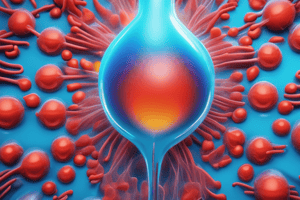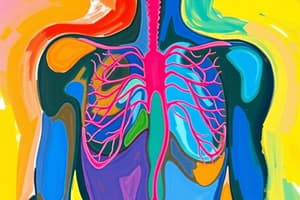Podcast
Questions and Answers
What hormone is secreted by alpha or A cells in the pancreatic islets?
What hormone is secreted by alpha or A cells in the pancreatic islets?
- Insulin
- Pancreatic polypeptide
- Somatostatin
- Glucagon (correct)
Which hormone is responsible for lowering blood sugar levels?
Which hormone is responsible for lowering blood sugar levels?
- Testosterone
- Insulin (correct)
- Somatostatin
- Glucagon
What is the function of somatostatin secreted by delta or D cells?
What is the function of somatostatin secreted by delta or D cells?
- Stimulates insulin secretion
- Stimulates glucagon secretion
- Promotes glucose absorption
- Inhibits both insulin and glucagon (correct)
What is produced by the F cells in the pancreatic islets?
What is produced by the F cells in the pancreatic islets?
What is the primary action of glucagon on hepatocytes?
What is the primary action of glucagon on hepatocytes?
Which hormone is primarily involved in regulating the menstrual cycle and maintaining pregnancy?
Which hormone is primarily involved in regulating the menstrual cycle and maintaining pregnancy?
What effect does high blood glucose (hyperglycemia) have on glucagon release?
What effect does high blood glucose (hyperglycemia) have on glucagon release?
Which of the following hormones does not inhibit FSH production?
Which of the following hormones does not inhibit FSH production?
What distinguishes the endocrine system from the nervous system?
What distinguishes the endocrine system from the nervous system?
Which of the following glands is NOT classified as an endocrine gland?
Which of the following glands is NOT classified as an endocrine gland?
What term describes hormones that act on neighboring cells?
What term describes hormones that act on neighboring cells?
How do hormones specifically affect their target tissues?
How do hormones specifically affect their target tissues?
What is the function of the hypothalamus in the endocrine system?
What is the function of the hypothalamus in the endocrine system?
What is the term for the process by which hormone receptors are reduced in number?
What is the term for the process by which hormone receptors are reduced in number?
Which of the following is a type of local hormone that acts on the same cell that secreted it?
Which of the following is a type of local hormone that acts on the same cell that secreted it?
Which statement regarding exocrine and endocrine glands is true?
Which statement regarding exocrine and endocrine glands is true?
Where is the pineal gland located?
Where is the pineal gland located?
What hormone is derived from serotonin?
What hormone is derived from serotonin?
During which condition is more melatonin produced?
During which condition is more melatonin produced?
What does the thymus produce that is involved in T cell maturation?
What does the thymus produce that is involved in T cell maturation?
What term describes helpful stress?
What term describes helpful stress?
What is the first stage of the general adaptation syndrome (GAS)?
What is the first stage of the general adaptation syndrome (GAS)?
Prolonged exposure to cortisol can lead to which of the following?
Prolonged exposure to cortisol can lead to which of the following?
What is one possible effect of stress on the gastrointestinal tract?
What is one possible effect of stress on the gastrointestinal tract?
What type of hormones typically use transport proteins to circulate in the bloodstream?
What type of hormones typically use transport proteins to circulate in the bloodstream?
Lipid-soluble hormones bind to which part of the target cell?
Lipid-soluble hormones bind to which part of the target cell?
Which of the following is NOT a type of water-soluble hormone?
Which of the following is NOT a type of water-soluble hormone?
What is the main role of second messengers in water-soluble hormone action?
What is the main role of second messengers in water-soluble hormone action?
Which factor does NOT affect the responsiveness of a target cell to a hormone?
Which factor does NOT affect the responsiveness of a target cell to a hormone?
What mechanism is primarily responsible for hormonal regulation in the body?
What mechanism is primarily responsible for hormonal regulation in the body?
What is the function of adenylate cyclase in water-soluble hormone signaling?
What is the function of adenylate cyclase in water-soluble hormone signaling?
Which of the following is a characteristic of eicosanoid hormones?
Which of the following is a characteristic of eicosanoid hormones?
What happens when a lipid-soluble hormone binds to its receptor?
What happens when a lipid-soluble hormone binds to its receptor?
What is a primary example of a hormone exerting a permissive effect?
What is a primary example of a hormone exerting a permissive effect?
What is the primary function of the hypothalamus in relation to the endocrine system?
What is the primary function of the hypothalamus in relation to the endocrine system?
Which type of hormones does the anterior pituitary primarily release?
Which type of hormones does the anterior pituitary primarily release?
What role does the hypothalamic-hypophyseal portal system play in hormone regulation?
What role does the hypothalamic-hypophyseal portal system play in hormone regulation?
Which of the following hormones is secreted by the anterior pituitary and stimulates growth?
Which of the following hormones is secreted by the anterior pituitary and stimulates growth?
What does follicle-stimulating hormone (FSH) stimulate in the ovaries and testes?
What does follicle-stimulating hormone (FSH) stimulate in the ovaries and testes?
Which hormone is primarily responsible for promoting milk secretion?
Which hormone is primarily responsible for promoting milk secretion?
What is the physiological role of adrenocorticotropic hormone (ACTH)?
What is the physiological role of adrenocorticotropic hormone (ACTH)?
Which hormone's role in humans is still unknown?
Which hormone's role in humans is still unknown?
Flashcards are hidden until you start studying
Study Notes
Endocrine and Nervous Systems
- The endocrine and nervous systems work in tandem to regulate body functions.
- The nervous system operates through nerve impulses and neurotransmitters, providing fast responses with brief effects on specific targets.
- The endocrine system utilizes hormones, which are released in one area but influence cells elsewhere, resulting in slower but longer-lasting effects.
Endocrine Glands
- Glands are categorized into exocrine (ducted) and endocrine (ductless).
- Endocrine glands secrete hormones directly into the interstitial fluid for diffusion into the bloodstream.
- Major endocrine glands include the pituitary, thyroid, parathyroid, adrenal, and pineal glands, alongside other organs like the hypothalamus, pancreas, and ovaries, among others.
Hormone Activity
- Hormones target specific tissues through specialized receptors, which are actively synthesized and degraded.
- Receptor regulation includes down-regulation, up-regulation, and the blocking of hormone receptors, exemplified by the drug RU486 (Mifepristone).
Types of Hormones
- Circulating hormones: Travel throughout the body via the bloodstream.
- Local hormones: Act in the vicinity of secretion, classified as:
- Paracrine hormones: Influence neighboring cells (e.g., IL-2).
- Autocrine hormones: Affect the secreting cell itself (e.g., NO).
Chemical Classes of Hormones
- Lipid-soluble hormones: Require transport proteins and include:
- Steroids derived primarily from cholesterol.
- Thyroid hormones (T3 and T4) linked to iodine.
- Nitric oxide (NO), functioning as both neurotransmitter and hormone.
- Water-soluble hormones: Function in free form and encompass:
- Amines.
- Peptides/proteins.
- Eicosanoids.
Mechanisms of Hormone Action
- Hormonal responses vary based on the hormone and receptor type.
- Lipid-soluble hormones interact with intracellular receptors, while water-soluble hormones bind to plasma membrane receptors, activating secondary messenger systems.
- Target cell responsiveness is influenced by hormone concentration, receptor abundance, and other hormonal interactions (permissive, synergistic, or antagonistic).
Hormonal Regulation and Feedback
- Hormone secretion is governed by:
- Nervous system signals.
- Blood chemical changes.
- Other hormones.
- Most hormone regulation occurs through negative feedback, with few exceptions for positive feedback.
Hypothalamus and Pituitary Gland
- The hypothalamus connects the endocrine and nervous systems.
- The pituitary gland, linked to the hypothalamus via infundibulum, consists of anterior and posterior sections.
- The anterior pituitary releases hormones regulated by hypothalamic releasing and inhibiting hormones, often classified as tropic hormones that influence other endocrine glands.
Anterior Pituitary Hormones
- Human Growth Hormone (hGH): Stimulates insulin-like growth factors (IGFs) for growth and protein synthesis.
- Thyroid-Stimulating Hormone (TSH): Promotes thyroid hormone production.
- Follicle-Stimulating Hormone (FSH): Supports ovarian and testicular functions.
- Luteinizing Hormone (LH): Triggers ovulation and testosterone production.
- Prolactin (PRL): Promotes milk secretion from mammary glands.
- Adrenocorticotropic Hormone (ACTH): Stimulates adrenal cortex glucocorticoid secretion.
- Melanocyte-Stimulating Hormone (MSH): Role in humans remains unclear.
Pancreatic Islets
- The pancreas functions as both an exocrine and endocrine gland, with 99% of its cells producing digestive enzymes.
- Pancreatic islets (Langerhans) contain:
- Alpha cells: Secrete glucagon to raise blood sugar levels.
- Beta cells: Release insulin to lower blood sugar levels.
- Delta cells: Produce somatostatin to inhibit glucagon and insulin.
- F cells: Secrete pancreatic polypeptide to inhibit several digestive functions.
Ovaries and Testes
- Gonads produce gametes and hormones.
- Ovaries generate estrogen and progesterone, crucial for reproductive functions, and inhibin to regulate FSH.
- Testes produce testosterone, regulating sperm production and male characteristics, also inhibiting FSH.
Pineal Gland
- Located at the midline of the brain’s third ventricle, it contains pinealocytes that secrete melatonin.
- Melatonin plays a role in regulating circadian rhythms, with production increasing in darkness.
Thymus and Endocrine Functions
- The thymus, behind the sternum, is vital for T cell maturation.
- It produces thymosin, thymic humoral factor (THF), thymic factor (TF), and thymopoietin.
Stress Response
- Eustress is beneficial, while distress is harmful.
- The body activates a general adaptation syndrome (GAS) in response to stress, comprising:
- Initial fight-or-flight reaction.
- Slower resistance phase.
- Potential exhaustion from prolonged cortisol exposure, affecting muscle, immune, GI, and pancreatic functions.
Studying That Suits You
Use AI to generate personalized quizzes and flashcards to suit your learning preferences.




